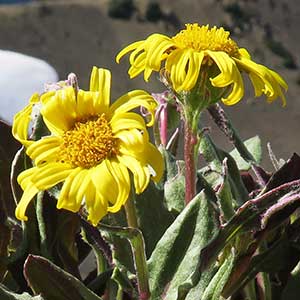Senecio integerrimus
Senecio neowebsteri
lambstongue ragwort, mountain butterweed, one-stem butterweed, tall western groundsel, western groundsel
Olympic Mountain ragwort
arachnose, loosely tomentose, or villous (hairs crisped, jointed), glabrescent.
(sometimes purplish-tinged) floccose-tomentose, unevenly glabrescent.
single.
single or loosely clustered (erect or arching).
progressively reduced distally; ± petiolate;
blades elliptic, lanceolate, linear, oblanceolate, rounded-deltate, or suborbiculate, 6–25 × 1–6 cm, bases ± tapered or truncate to cordate, margins entire or ± dentate (distal leaves sessile, bractlike).
mostly cauline; petiolate (petioles about equaling blades);
blades lanceolate or oblanceolate to ovate, (2–)4–8+ × 1.5–3 cm, bases tapered, margins denticulate (distal leaves smaller, lanceolate or linear-lanceolate, bractlike).
usually ± 8 or ± 13, sometimes 0;
corolla laminae 6–15(–20) mm (usually yellow, ochroleucous to white in one variety).
± 13;
corolla laminae ± 15 mm.
usually ± 13 or ± 21, rarely ± 8, (4–)5–12(–15) mm, tips usually black, sometimes green.
usually ± 21, sometimes ± 13, (8–)10–15 mm, tips usually greenish (often sparsely hairy).
of 1–5+ linear to filiform bractlets (seldom more than 2 mm).
of 4–8 lanceolate to lance-linear bractlets (lengths mostly less than 1/2 phyllaries).
6–20(–40+) in corymbiform arrays (peduncle of terminal head often shorter than others).
nodding, 1(–2).
usually glabrous, sometimes hirtellous (mostly on angles).
glabrous.
= 40, 80.
= 40.
Senecio integerrimus
Senecio neowebsteri
Varieties 5 (5 in the flora).
The varieties of Senecio integerrimus are distinguished by morphology and geography.
(Discussion copyrighted by Flora of North America; reprinted with permission.)
Of conservation concern.
(Discussion copyrighted by Flora of North America; reprinted with permission.)
1. Basal leaves with distinct petioles, blades usually ovate to rounded-deltate, sometimes obovate to oblanceolate; ray corollas white or ochroleucous | var. ochroleucus |
1. Basal leaves with or without distinct petioles, blades elliptic, lanceolate, oblanceolate, rounded-deltate, sublinear, or suborbiculate; ray corollas yellow (or rays 0) | → 2 |
2. Herbage glabrous or glabrate at flowering (except in leaf axils and among heads); phyllaries linear-subulate, tips usually green, minutely (if at all) black | var. integerrimus |
2. Herbage usually arachnose, tomentose, or villous at flowering; phyllaries lanceolate to linear-subulate, tips black (if minutely so, then narrowly lanceolate and broader than subulate) | → 3 |
3. Basal and proximal leaves oblong or lanceolate to sublinear; heads 3–6(–16+); phyllaries 10–15+ mm | var. scribneri |
3. Basal and proximal leaves mostly elliptic to oblanceolate, sometimes elliptic or rounded-deltate to suborbiculate; heads usually 6–15(–30+; if fewer than 6, leaves lanceolate or broader); phyllaries 5–12 mm. | → 4 |
4. Plants copiously arachnose, tomentose, or villous at flowering; phyllaries linear-subulate, 8–12 mm, tips minutely, if at all, blackened | var. major |
4. Plants copiously to sparsely arachnose, tomentose, or villous at flowering; phyllaries mostly lanceolate (seldom as narrow as linear-subulate), 5–10 mm, tips black | var. exaltatus |
- Local floras:
BC,
CA,
OR,
WA
- Local Web sites:
CalFlora,
CalPhotos,
Flora NW,
KS Wildflowers,
MN Wildflowers,
PNW Herbaria,
Turner Photog.
WildflowerSearch
iNaturalist (observations)
USDA Plants Database
- LBJ Wildflower Center
- SEINet
- Plants of the World Online
- Encyclopedia of Life
- Wikipedia
- Google Image Search


